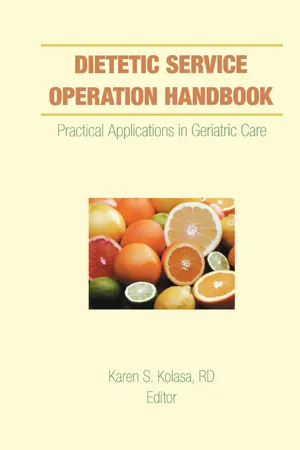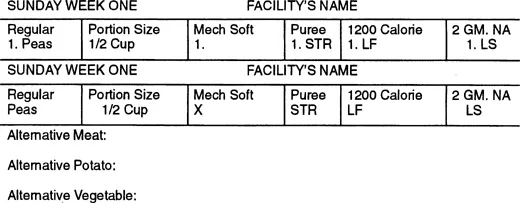
Dietetic Service Operation Handbook
Practical Applications in Geriatric Care
- 176 pages
- English
- ePUB (mobile friendly)
- Available on iOS & Android
About this book
Approved by the Dietary Managers Association for 9 CEUs.Here is a useful guide that helps both administrators and food service workers understand the daily functions of their dietary departments. Dietetic Service Operation Handbook enhances extended caregivers'knowledge of basic food service and clinical dietetics operations and serves as a functional tool they can use to initiate effective organization of dietetic services. It explains proper techniques and tips for everything from how to plan a menu and care for equipment to special adaptive eating devices and modifying texture for swallowing disorders. Packed with general and specific guidelines, this book also teaches food service employees how to allocate time more wisely, making them effective members of the interdisciplinary medical team--and saving their facility time and money as well. Administrators who wish to understand the functions of their dietary department so they can communicate more effectively with its staff will find this book a most useful resource, full of meaningful interpretations of routine tasks found in the daily operation of a food service.The author, registered with the American Dietetic Association, has prioritized the topics in the book to assist the systematic organization of any dietary department. Chapters cover both administrative and clinical topics, including food purchasing and production, the policy and procedure manual, quality assurance, current trends in geriatric nutrition, the effects of medicine on diet, enteral feeding, and documentation of the medical record. Dietetic Service Operation Handbook includes a wide variety of standardized recipes for the pureed diet, a resource list, handy calculations, and many useful forms for record-keeping which are compatible with OBRA laws. Beginning dietitians and dietary managers will find this book to be an extremely helpful and practical guide in their day-to-day
Frequently asked questions
- Essential is ideal for learners and professionals who enjoy exploring a wide range of subjects. Access the Essential Library with 800,000+ trusted titles and best-sellers across business, personal growth, and the humanities. Includes unlimited reading time and Standard Read Aloud voice.
- Complete: Perfect for advanced learners and researchers needing full, unrestricted access. Unlock 1.4M+ books across hundreds of subjects, including academic and specialized titles. The Complete Plan also includes advanced features like Premium Read Aloud and Research Assistant.
Please note we cannot support devices running on iOS 13 and Android 7 or earlier. Learn more about using the app.
Information
ADMINISTRATIVE TOPICS
I. Menu Planning

Table of contents
- Cover
- Half Title
- Title Page
- Copyright Page
- Dedication
- Table of Contents
- About the Author
- Introduction
- Administrative Topics
- Clinical Topics
- Appendix
- Index